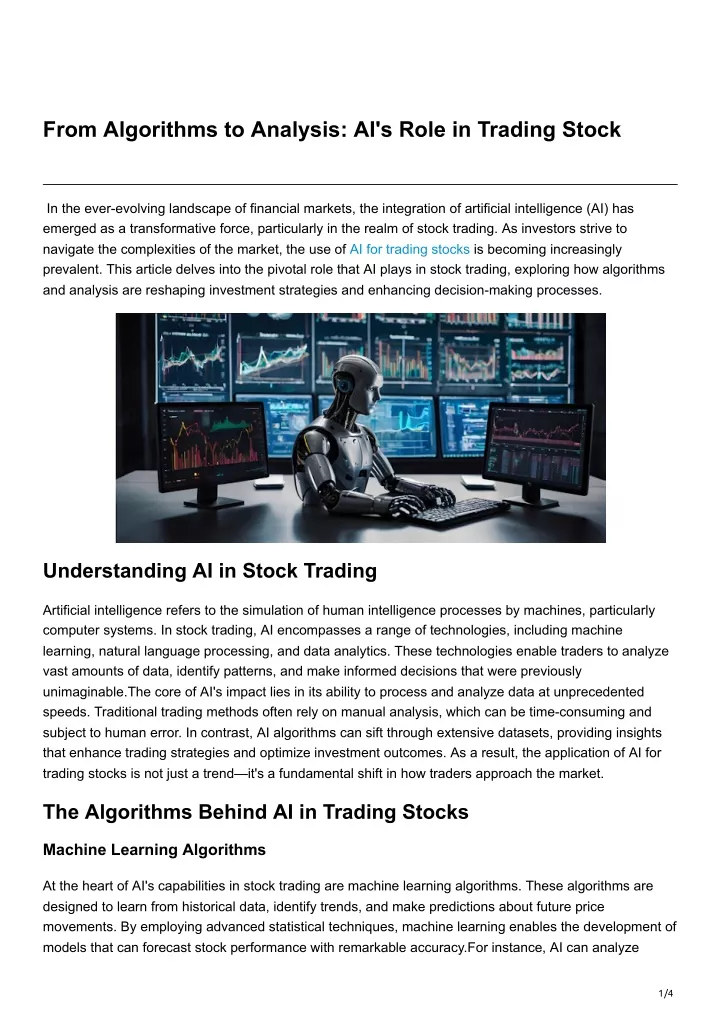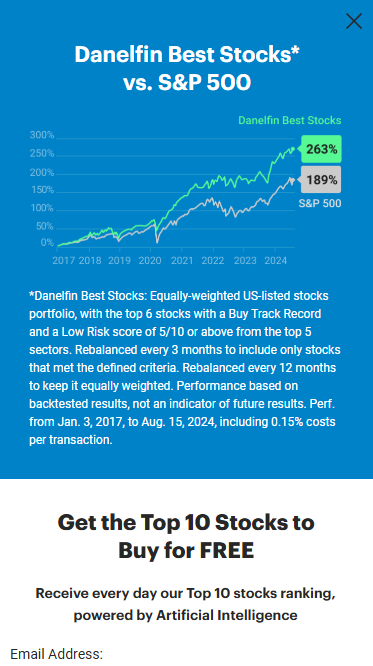The ability to customize the trading platform according to your trading goals, tolerance for risk, and the current market conditions is an important feature of AI-based stock prediction and analysis trading platforms. Platforms with powerful customization features can improve your trading efficiency. Below are the top ten tips to evaluate the capabilities to customize strategies on these platforms:
1. Evaluate Pre-Built Strategy Templates
The variety of templates available: Find out if the platform offers various pre-designed strategies that can be used for various trading styles (e.g. swing trading, day trading, and long-term investing).
You can easily modify the templates and tailor them to your specific needs.
Performance history: Check whether the platform provides historical performance statistics on the an already-built strategy.
2. Create a custom strategy
Drag-and-drop tools: Search for platforms that have user-friendly drag and drop interfaces to customize strategies.
Options for Coding: For users who are more advanced, check if the platform allows custom coding in a scripting language that is proprietary (e.g. Python, R).
Flexibility. You must identify key elements such as the parameters for risk management, entry and exit regulations, and other elements of your strategy.
3. Check for Backtesting Capabilities
Data historical: See if there are enough facts to back-test your strategies.
Modifiable parameters: Make sure you have the ability to alter parameters (e.g., timeframes, indicators) when backtesting.
Performance metrics - Make sure to see if your software has specific performance indicators (e.g. the winning rate, Sharpe coefficient, or drawdown) for all strategies tested back.
4. Evaluate Real-Time Strategy Testing
Paper trading Try out strategies in real-time using simulation or paper trading.
Live testing is an excellent method of determining if your strategy can be implemented in the real world market using small amounts.
Real-time adjustments: You should see if your strategy can be adapted in real-time to market conditions.
5. Evaluate the degree of integration with technical indicators
Indicator library - Check whether a platform offers an extensive collection of indicators that are technical, including moving averages (e.g. RSI), MACD, or RSI.
Custom indicators - Ensure that you can build or import your own custom indicators.
Combination of indicators: Look to see if the system supports combining multiple indicators for more complex strategies.
6. Check for Risk Management Tools
Stop-loss/take-profit: Ensure the platform allows you to set stop-loss and take-profit levels within your strategies.
Position sizing. Consider whether you could create rules for sizing positions (e.g. percentage, set amount) and also manage risk.
Risk-reward Ratio: Verify that the platform allows setting individual risk-reward limits for strategies and trades.
7. Evaluate Multi-Asset Strategy Support
Asset classes: Ensure that the platform can handle different asset classes, including ETFs, stocks and options.
Strategies for cross-assets: Determine if you're able to design strategies that take advantage of different asset classes.
Market coverage: Check if the platform covers the markets you're looking for (e.g., US, international, cryptocurrencies).
8. Evaluate Automation and Execution
Automated trading - Ensure that the platform can be capable of automating strategies based on the established rules.
Order types - Check that the platform supports a variety of order types to execute strategies (e.g. stop, limit or market).
Check for latency: Make sure that the platform permits trades to be executed with the least amount of latency. This is crucial for high-frequency strategy.
9. Take a look at the Strategies Optimization Tools
Optimization of parameters - Make sure that the platform has tools for optimizing the strategy parameters.
Machine learning integration. Check if your platform incorporates machine learning in order to improve and refine strategies.
Scenario Analysis: Find out whether the platform can test strategies across different markets (e.g. bull or bear and volatile).
Review Community Support and User Feedback
User reviews: Examine reviews from users to assess the effectiveness of the platform for strategy customization.
Community forums. Verify if members are able to share information and discuss their ideas in a vibrant community.
Support resources: Ensure that the platform provides tutorials, webinars or documentation that will help users develop and optimize their strategies.
Bonus Tips
Trial period: Try an unpaid trial or demo to experience the platform's customization features.
Scalability - Ensure the platform you choose is able to manage your ever-changing trading strategies.
Customer Support: Ensure that the platform has assistance for any concerns related to strategy or questions.
These tips will aid you in assessing the capability of AI trading platforms to modify their strategies. You will be able determine which platform best suits your needs in trading and allow you to improve and implement your plan. A platform that has powerful customization options will allow you to adapt to changing market conditions and boost the performance of your trading. View the top basics on AI stock trading app for more examples including AI stock trading bot free, best AI stock trading bot free, ai trading tools, market ai, chatgpt copyright, ai investing app, AI stock picker, investment ai, trading ai, investment ai and more.

Top 10 Ways To Evaluate The Speed And Latency Ai Technology For Predicting And Analyzing Stocks
Latency and speed are a critical factor when evaluating AI software for stock prediction or analyzing trading platforms. This is especially important for high-frequency traders, algorithmic traders, as well as active traders. A delay of just milliseconds can negatively impact profitability and trade execution. Here are 10 tips to assess the speed and speed of these platforms.
1. Examine the Real-Time Data Feeds
Data delivery speed: Ensure that the platform is able to deliver real-time information with the least amount of delay (e.g., less than a millisecond delay).
Verify the source's proximity to most important exchanges.
Data compression: Determine whether your platform uses efficient techniques for data compression to speed up the delivery of data.
2. Test the Trade Execution speed
Time to process orders: Determine how quickly the platform process and executes trades when you submit an order.
Direct market access (DMA). Make sure the exchange you're using has DMA. DMA allows orders that are sent directly to exchanges to be processed without any intermediaries.
Execution reports: Find out whether the platform offers detailed execution reports, including timestamps for the submission of orders, confirmation of orders and fill.
3. Assess Platform Receptiveness
User interface (UI or user interface speed) It is the speed at which a platform's UI responds to the inputs you enter (e.g. pressing buttons or loading graphs).
Chart updates: Check if charts and visualizations update in real-time without lag.
Mobile apps' performance If you're using a mobile app ensure that it runs at the same speed as a desktop version.
4. Look for low latency infrastructure
Server Locations: Ensure that the platform uses servers that are low-latency and located near major hubs for financial exchanges or financial hubs.
Co-location service: Find out whether your exchange offers this option. This allows you to host trading algorithm on servers near the exchange.
High-speed Networks: Check the platform's use of high-speed, fiber-optic network or other technologies with low latency.
5. Check the backtesting speed and simulation speed.
Test the speed at which your platform is able to analyze and process the historical data.
Simulation latency: Make sure that the platform is able to simulate trades in real-time without significant delays.
Parallel processing: Find out whether the platform uses parallel processing or distributed computation to speed up calculations.
6. Measure API Latency
API responses: Determine how fast APIs can respond to requests (e.g., fetching information from the platform, or placing orders).
Limits on rates. Check the API's rate limits to avoid delays while high-frequency trading.
WebSocket support: Check whether your platform is using WebSocket protocols for real-time, low-latency streaming of data.
7. Test Platform Stability under Load
High-volume Trading: Simulate high quantities of trading scenarios in order to test if your platform is stable and responsive.
Market volatility Test the platform in periods of high market volatility to see if it can handle rapid price fluctuations.
Test for stress: Check whether your platform has methods for stress testing strategies in extreme circumstances.
8. Assess Connectivity and Network
Internet speed requirements. Check that your internet connection has the standards for your platform to guarantee optimal performance.
Redundant connections: Check if the platform supports redundant internet connections to prevent the possibility of downtime.
VPN latency. If you're using VPN, VPN be sure to check if it introduces significant latency.
9. Make sure you are aware of features that speed-optimize your computer.
Pre-trade Analytics: Be sure the platform has pre-trade analytics to optimize the routing of orders, execution speed and other variables.
Smart order route (SOR) : Check to see if SOR is being used by the platform in order to determine the most speedy and cost-effective execution venues.
Check the platform's tools to analyse and monitor latency in Real-Time.
Benchmarks for User Feedback Review
Reviews from users: Search for feedback from users on the platform to gain an understanding of its speed and latencies.
Benchmarks from third-party sources: Search for reviews and benchmarks from independent sources which compare the performance of the platform to those of its competitors.
Case studies: Check if the platform offers cases studies or testimonials, highlighting its abilities to provide low-latency.
Bonus Tips:
Free trial period: Try the platform's performance and latency in real-world situations using the demo or free trial.
Customer support: Make sure that the platform provides assistance for issues related to latency or for optimization.
Hardware requirements: Check whether you require special hardware for optimal performance (e.g. high-performance computers).
Utilizing these guidelines, it is possible to precisely assess the speed, latency and the accuracy of AI stock prediction/analyzing trading systems. This will enable you to choose a platform according to your specific needs in trading, while also minimizing any delays. A low latency, particularly for algorithms and high-frequency trading, is essential. Even small delays can greatly impact profit. Check out the recommended stocks ai advice for blog advice including best ai trading platform, ai options trading, best stock prediction website, stocks ai, how to use ai for copyright trading, ai copyright signals, best AI stock prediction, free AI stock picker, best AI stock prediction, ai in stock market and more.
